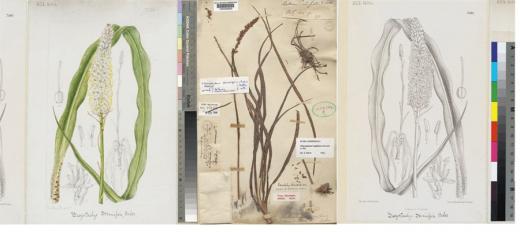In the lab: Livingstone’s Zambezi expedition

JSTOR Global Plants has gotten very big–at last count some 2,222,000 plant type specimens and 245,000 primary sources were contained within it. That enormity has helped it to become an indispensable resource for plant taxonomists and botanists but can be overwhelming to non-specialists. At the GPI conference last September, our team spoke with many partners about the potential for highlighting smaller segments of Global Plants content, such as specimens and historical documents from a single expedition, and it was exciting how many shared our enthusiasm.
With these conversations in mind, we began experimenting with how we could present specimens within a robust historical context. Earlier this year we teamed up with JSTOR Labs, an interdisciplinary team that works to get new ideas and concepts off the ground. Knowing that Global Plants and JSTOR contain letters, reports, specimens, and botanical illustrations from Livingstone’s Zambezi Expedition (1858-1864), we decided to build a map connecting the specimens that were collected with the other materials produced as a result of the expedition.
In the Lab
Inspired by the New York Public Library Labs’ work with New York City historic maps, JSTOR Labs started to tinker with Map Warper, an open source tool to overlay historic maps on top of today’s geo-precise maps. We pinned all of the relevant content we found from Global Plants and JSTOR onto this layered map. This included maps drawn during the expedition, letters to and from members of the expedition party, reports to the Rogal Geographic Society on the expedition’s progress (and gruff dismissals of requests for more money), and, of course, hundreds of plant specimens that the expeditions’ botanists, John Kirk and Charles Meller, sent back to Kew. On top of all this, we added an animated timeline to help people discover how the expedition unfolded over time.
Results
We think exploring the content both geographically and chronologically is exciting and powerful. For example, you can see what kinds of plants were collected in the same vicinity at the same time of year, or compare the Comretum imberbe Wawra specimen that Kirk collected in 1859 to the sample of Combretum imberbe Wawra wood the expedition donated to the Royal Botanic Gardens, Kew the following year. Or you can examine the Dasystachys drimiopsis Baker illustrations that Matilda Smith created for Curtis’ Botanical Magazine in 1898 alongside the original specimen, collected by Kirk in 1859 (see image at the top of this post).
These sorts of connections are certainly possible to uncover in Global Plants, but it can be difficult. The Zambezi Expedition objects represent just .033 percent of the total content in Global Plants! It is our hope that curating these materials will help researchers, teachers, and students discover the important stories contained inside of this collection; stories like Livingstone’s dawning awareness of the horrors of slavery, the conflict and correspondence with the expedition funders, and personal stories like the tragic death of Livingstone’s wife. We also hope it might inspire librarians, archivists, and publishers–and anyone who is a custodian of such rich historical and cultural material–to find ways to share and enrich that content. In doing so, they’ll make it possible for researchers to get a bit of the same thrill of discovery that Livingstone experienced… but with fewer mosquitoes.